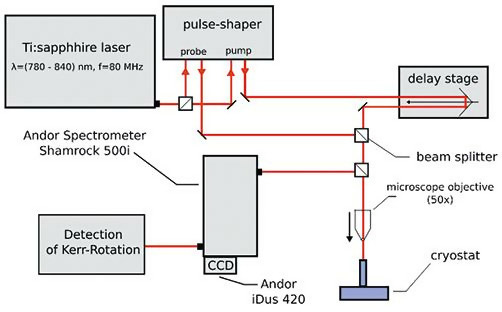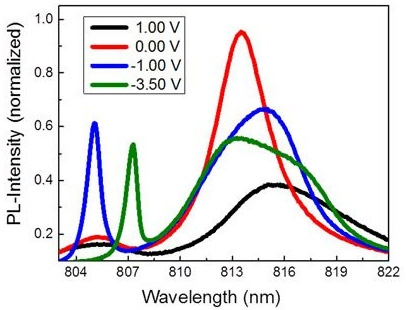Resources
 Part of the Oxford Instruments Group
Part of the Oxford Instruments Group
Expand
Collapse
 Part of the Oxford Instruments Group
Part of the Oxford Instruments Group
Introduction
The quantum mechanical spin of electrons in semiconductors is a promising feature for novel applications, e.g. in the area of quantum computing. Therefore, it is highly relevant to investigate the intrinsic properties of electron spins in semiconductor based materials with a special focus on their fast manipulation and control.
The coherent orientation and detection of a spin ensemble in GaAs based semiconductor samples, like ours, is best achieved by making use of ultra-short (femtosecond) light pulses in combination with pumpprobe type spectroscopy. For such setups, a versatile spectral control and simultaneous monitoring is essential.

Figure 1: Combination of an Andor spectrometer (Shamrock 500i) and CCD detector (iDus 420) embedded in the experimental setup used for the investigation of spin-dynamics in GaAs quantum wells.
Experimental application
The combination of an Andor spectrometer (Shamrock SR-500i-B1-SIL) and CCD detector (iDus DV420A-OE) as depicted in Fig. 1 supports our experiment in various ways.
Firstly, to achieve a non-degenerate pumpprobe regime both light beams are separately sliced out from the spectrally broad Ti:sapphire laser pulses using a pulse shaper in 4f geometry. The resulting wavelengths can be easily controlled by the CCD camera which monitors the reflection of both beams from the sample. This technique allows for a precise and individual spectral positioning of pump and probe pulses while monitoring the outcome of the pulse shaper in real time.

Figure 2: Photoluminescence of the GaAs-QW obtained by using the Andor CCD (iDus 420). The different data sets represent an increasing carrier density in the QW adjusted by decreasing the gate voltage at the sample. (1)
Secondly, the combination of spectrometer and CCD is used to measure the Photoluminescence (PL) emerging from the GaAs quantum well (QW) which is located in a cryostat and illuminated with the pump beam tuned above the band-gap to 780 nm as shown in Fig. 2.
The obtained PL appears in the spectral window of 800 nm to 830 nm which can be easily covered by the CCD. Note that the spectrometer grating is set to a position where the pump beam does not impinge on the CCD array to avoid unwanted saturation.
Finally, the spectrometer is used to separate the co-propagating pump and probe reflection by making use of their spectral non-degeneracy. This step is crucial to prevent the pump light to enter the detection scheme for the Kerr-rotation of the probe beam which serves as a direct measure for the spin-polarization in the QW.
Thereby, the spectrometer grating is set to the probe wavelength which is at the excitonic resonance, usually found in the range of 803 nm to 818 nm, hence the pump light with 790 nm does not pass through the spectrometer.
Experimental results
The application of the spectrometer and CCD as discussed above enables a broad variety of measurements related to spin dynamics and their spectral dependence.
The goal of these studies is to investigate electronic spin lifetimes in the QW and, ultimately, to perform spatially resolved measurements of lateral spin transport.
However, all of these measurements depend on a previous check of the PL which facilitates the decision for the appropriate probe wavelengths. In our case this control is even more crucial as a change of gate voltage on the sample goes along with an altered electron concentration in the QW. This density in turn has a direct impact on the band transition and, at the same time, influences the related spin properties as illustrated in Fig. 2.
Furthermore, a direct remote control of the grating via the customized LabView code provided by Andor gives rise to fast and direct measurements of spin properties in dependence of the spectral probe position.
The main result in terms of spin dynamics is that intermediate carrier densities in the QW come along with a substantial enhancement of the spin lifetime and coherence time. [1] In addition, spatially resolved measurements give direct insight into subtle details of the electronic spin-orbit coupling. In particular, we find coherent spin rotations on the 10 μm length scale which can be attributed to spin-orbit coupling in noncentrosymmetric structures.
References
Date: March 2017
Author: S. Anghel, F. Passmann, M. Betz, Experimentelle Physik 2, Dortmund
Category: Application Note
